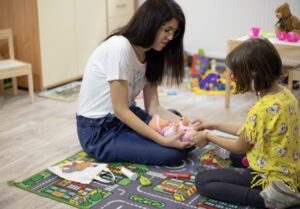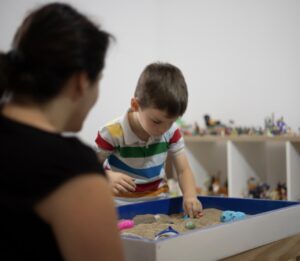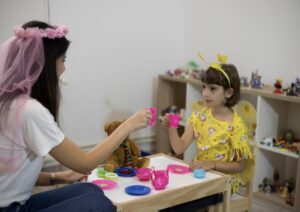Demystifying the Playroom
Parents often search for a therapist for their child with an adult therapy model in mind, something they have seen on TV or experienced in their own lives, an article they read online, or just someone for their child to talk to. When they see our play therapy sessions, they might actually feel quite confused.

Why is my child who needs to work through their experiences of bullying, sitting on the floor with their therapist dressing up dolls? Why is my child who throws tantrums about homework doing a telehealth scavenger hunt around the house for four objects that are fun to touch? Why is my child’s therapist letting them beat the heads off puppets and knock over all the neatly lined up figurines? Why is my teenager playing in a sand tray, constructing war scenes with plastic soldiers and snakes?
Despite their puzzlement, parents come back over and over, recommending their friends and family to play therapy, and offer we play therapists deep gratitude for helping their child. Why? Because it works. Kids often love to come to their play therapy appointments, and parents see the changes, growth and healing they came for. But even at graduation, when we are closing the therapeutic relationship and wishing the family well in future life adventures, parents might still be quite confused about how this progress happened.

Some of what we do is hard to explain. As a play therapist, I don’t always know what your child is thinking or feeling. But I can feel the “work” happening: trust, self agency, resolution, language and expression of emotion, self-regulation, power over the problem, empathy and understanding others, and confidence. We, as adults, have meanings for these words and so they help us contain our process of healing, growth and change. But a child needs other containers, and actually some of their containers are even more powerful than words. A child’s container is play, imagination, storytelling, action and adventure, creation, and a real connection that feels authentic to them, smiling together with a twinkle in their eye.
Kids go straight for what they need in the playroom, and every child’s journey there is unique. Some children need to strengthen self-regulatory and executive functioning. Others need support adjusting to changes in their family life. Some are processing traumatic events, developing the alchemy of resilience. Some kids come to learn social skills. Some problem monkeys like anxiety and depression might be hanging on to a child when they first enter the playroom. Some children need parent-child relationship dynamics to shift, so I pull the parent in to play games targeting attachment and family structure.
Would you like to experience this connection with your child? Try playing with them, letting them lead you into their emotional world. Stay in the metaphor with them. That’s where they feel safe to work through the bigness of life on a scale they can hold in a crayon, throw something into a basket, bury things in the sand tray, or put back something on a shelf and leave at the end of their story. And that’s where they’ll find us as play therapists. Welcome to the playroom!

About the Author: Masumeh Farchtchi, M.S., is a Resident in Marriage and Family Therapy. Masumeh enjoys working with children, teens and families as they reach their goals through a range of challenging contexts, including: complex trauma, mood disorders such as anxiety and depression, developmental disability, domestic violence, family life cycle transitions like launching, family conflict, and grief and bereavement.
